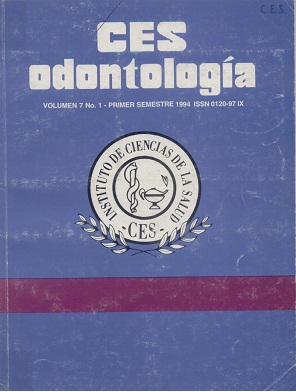EXACTITUD DE LOS INDICES DE TRANSFERENCIA PARA SOLDADURA USANDO TRES DIFERENTES TIPOS DE ACRILICOS
Resumen
Los pasos para la confección de una prótesis par¬cial fija son numerosos y si a éstos les adicionamos estos pasos necesarios para la realización de una soldadura metálica, nos estaríamos alejando cada vez más del patrón original que inicialmente son las preparaciones dentarias.Los primeros estudios fueron realizados bajo pará-metros poco científicos y su evaluación se hizo según los logros clínicos obtenidos (Meyer 1959). Muchos otros reportes se basan en describir técni-cas empleadas para la fabricación de índices de transferencia pero sin hacer estudios comparativos (Andersen 1958).En la presente investigación se compararon tres tipos de materiales acrílicos cuyo principal compo-nente es el polimetacrilato de metilo, utilizando el método comúnmente empleado para llaves de transferencia en boca (Polímero y monómero mani-pulado con un pincel).Para la parte experimental se fabricó un troquel rectangular de acero. Cada par de cilindros se en-contraba a una distancia de 0.5 mm, espacio utiliza-do para colocar los diferentes acrílicos. Los acrí¬licos utilizados fueron: Duralay y acrílico rosado.Los cilindros se dividieron en 4 grupos con fines de manejo estadístico, siendo uno utilizado como gru¬po control y los otros tres como grupos experimen¬tales. Las mediciones se realizaron a las 6, 24 Y 48 horas.Los resultados obtenidos en este estudio demues-tran que no existen diferencias estadísticamente significativas entre los materiales e intervalos de tiempo usados para las mediciones; sin embargo, hubo diferencia con respecto a las mediciones ini-ciales por la contracción que sufrieron los materia-les, obteniéndose más estabilidad con el acrílico rosado.
Abstract The steps in orderto elaborate a fixed partial denture are numerous and if the necessary steps for the making of a solder joint are added there would be an increased distance from the dental preparation, which is the origi¬nal pattem.The first studies were done with unscientific parameters (Meyer, 1959). Many reports are based on the description of techniques employed in the fabrication of transferation indices but without doing any comparative studies (Andersen, 1958).In this study, comparisons were made between three different types of materials whose main component is methyl polymethacrylate utilizing the conventional method for transferation keys in the oral cavity (polymer and monomer manipulated with a brush).The experimental design included the fabrication of a stainless steel rectangular dice. Each pair of cylinders were at a distance of 0.5 mm., which was the space used for the placement of two different acrylics, which were Duralay (Kerr) and an autopolymerizing acrylic (New Stetic) .The sample consisted of three experimental and one control group and measurements were made at 6, 24 and 48 hours.The results indicate that no statistical significant differences exist between the materials used and the time intervals between measurements. There was,however, a difference with respect to the initial measurements due to the contraction of the materials and as a result there was more stability with the autopolymerizing acrylic.
Descargas
Los datos de descargas todavía no están disponibles.
Descargas
Publicado
2011-09-05
Cómo citar
1.
Ruiz Londoño JC. EXACTITUD DE LOS INDICES DE TRANSFERENCIA PARA SOLDADURA USANDO TRES DIFERENTES TIPOS DE ACRILICOS. CES odontol. [Internet]. 5 de septiembre de 2011 [citado 23 de julio de 2024];7(1):17-23. Disponible en: https://revistas.ces.edu.co/index.php/odontologia/article/view/1567
Número
Sección
Artículo de Investigación Científica y Tecnológica
| Estadísticas de artículo | |
|---|---|
| Vistas de resúmenes | |
| Vistas de PDF | |
| Descargas de PDF | |
| Vistas de HTML | |
| Otras vistas | |



